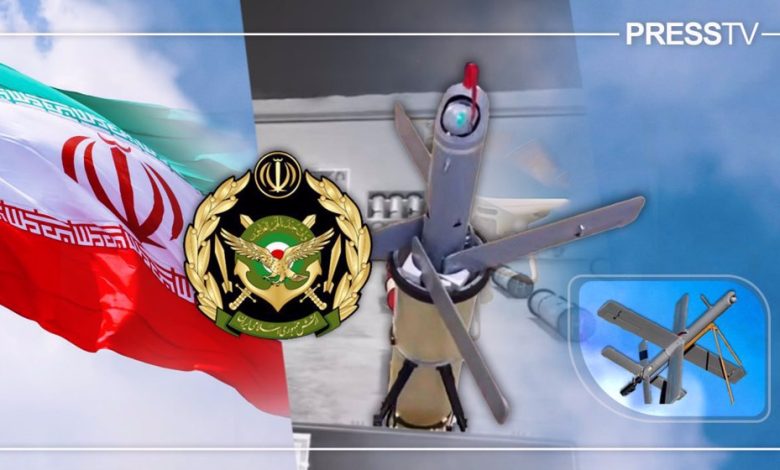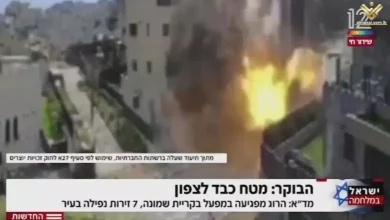Analysis: Why Iran’s Rezvan and Raad loitering munitions considered strategic assets
In the Payambar-e-A'azam 19 (The Great Prophet 19) military exercises, Iran's armed forces showcased and evaluated state-of-the-art loitering munitions, underscoring their swiftly evolving military capabilities.

In a significant development at a major military installation, the Rezvan loitering munition was officially unveiled to the public. The event also showcased state-of-the-art combat drones and precision-guided missiles, as media representatives gathered to witness the latest advancements in military technology.
Simultaneously, the Raad loitering munition was subjected to testing in Iran’s western Kermanshah province.
In a recent development, the Iranian military has taken delivery of a new fleet comprising 1,000 domestically manufactured drones. These state-of-the-art drones are equipped with radar-evading technology and are capable of engaging targets at a distance of over 2,000 kilometers, underscoring Iran’s expanding defense capabilities.
A loitering munition, often referred to as a “suicide drone” or “kamikaze drone,” is a type of aerial weapon system designed to linger in the airspace over a target area for an extended period. These munitions are equipped with onboard sensors and navigational systems, enabling them to identify, track, and engage targets with precision. Unlike traditional missiles, loitering munitions can abort missions if the target is not confirmed, and they are capable of returning to base if not employed, making them a versatile tool for modern military operations.
Loitering munitions, a category of disposable drones that come equipped with integrated warheads, are engineered to hover over a designated target area, strategically awaiting the optimal moment to execute an attack by colliding with the target.
Commonly known as suicide, kamikaze, or one-way-attack drones, these weapons distinguish themselves from standard models with significant operational versatility. Unlike the traditional kamikaze drones, which are essentially guided to function as miniature cruise missiles, loitering munitions are equipped with advanced capabilities allowing them to modify their trajectories during flight. Remarkably, they possess the ability to abandon their mission and return to base if they do not identify a suitable target.
Equipped with advanced sensors, precision guidance technology, and adaptable warheads, loitering munitions possess the capability to locate, identify, monitor, and accurately strike both stationary and moving targets.
Depending on their specific model and design, these devices are capable of hovering for extended periods, ranging from several minutes to much longer durations. Target acquisition can be controlled by a ground operator utilizing real-time imagery, or it can be managed autonomously, without the need for human intervention.
Compact, portable, and readily deployable, loitering munitions present significant challenges in detection and interception. These attributes render them formidable assets in undermining enemy capabilities and morale.
In recent years, drones have experienced a notable increase in utilization, demand, and technological advancement, establishing themselves as a cost-effective and dependable substitute for conventional high-value platforms.
The ongoing conflict between Russia and Ukraine has underscored the adaptability of modern warfare technology, as long-range loitering munitions have been effectively deployed to hit targets located hundreds of kilometers away. Simultaneously, tactical versions of these munitions have been instrumental in transforming the dynamics of frontline engagements.
Despite their increasing visibility, no definitive solutions have yet been developed to counter loitering munitions effectively, especially on the tactical battlefield. According to military analysts, current countermeasures are costly, scarce, and frequently lack reliability.
The development of loitering munitions continues to advance, integrating state-of-the-art technologies including improved sensors, artificial intelligence-based capabilities, increased resistance to jamming, quieter and more efficient engines, and aerodynamic designs that facilitate smooth flight and agile maneuvers.
These innovations are increasingly reinforcing their status as a transformative force in contemporary military operations.
Key characteristics of Raad and Rezvan include their distinct capabilities and features which are designed to fulfill specific functions. Raad is known for its robust performance and versatility, often being employed in various strategic applications due to its reliable precision and effectiveness. Meanwhile, Rezvan is distinguished by its advanced technological integration, providing enhanced efficiency and sophistication in its operations. Both are recognized for their innovative designs and ability to adapt to diverse operational requirements.
Iran’s military has announced the introduction of the Raad and Rezvan loitering munition systems, releasing images and footage of the new technology. However, detailed technical specifications for these systems have not been disclosed.
The initial footage of the Raad missile test was unveiled in February of the previous year, initially presented without a designation. The name of the weapon was only disclosed in recent days.
In April, Iranian media outlets, drawing comparisons to the Russian Lancet system, projected the capabilities of an unmanned aerial system to include a flight endurance ranging from 30 to 60 minutes, an operational range of approximately 40 kilometers, and a warhead capacity between 3 to 6 kilograms.
Rezvan was unveiled for the first time last Thursday, with only its front half visible from a cylindrical launcher. The drone is reported to have a range of 20 kilometers and a flight duration of 20 minutes, categorizing it as a short-range tactical drone.
Both drones are equipped with tactical X-wings to improve maneuverability during dives, though they differ in their launch mechanisms. The Raad drone employs a booster and is deployed from a tripod, setting it apart from Russia’s Lancet and Scalpel systems, which are launched using a catapult and have a distinct wing design.
The Raad missile is equipped with four fixed lifting wings and four smaller tail fins that are manually attached before launch. In contrast, the Rezvan missile features foldable wings that expand during the launch process.
Details regarding the tail fin configuration of the Rezvan remain undisclosed, with some models, like the Russian Izdeliye-53, notably lacking such features. Additionally, the specific type of propulsion system employed by the Rezvan is uncertain, though it is widely speculated to be powered by a propeller.
Furthermore, taking into account the previously mentioned range, the electric motor is anticipated to operate with a noise level considerably lower than that of a traditional fuel-powered piston engine, thereby enhancing its ability to stealthily approach adversaries during a dive.
Raad and Rezvan are equipped with a distinctive rotatable pod featuring cameras and sensors situated in the lower section of the nose, setting them apart from comparable international drones.
A key distinction between last year’s model and the recently unveiled Raad is the incorporation of a vertically mounted antenna on its structure.
The Islamic Revolution Guards Corps (IRGC), in collaboration with local knowledge-based companies, has successfully developed two loitering munitions, as reported by military sources.
The Raad and Rezvan tactical equipment have been deemed essential for safeguarding Iran’s borders in the mountainous regions, notably in the northwest and southeast. These areas are known for the presence of foreign-backed terrorist groups, making such equipment crucial for national security.
In recent years, groups familiar with the local terrain have attempted to infiltrate the country with sabotage units. However, in the majority of instances, these efforts have been thwarted through ambushes.
The latest advancements in loitering munition systems offer a more efficient approach to addressing terrorist and sabotage groups from a secure distance, significantly reducing the risk of human casualties.
**Comparison of Iranian and International Systems**
Both Iran and several other countries have developed systems with similar functionalities, reflecting shared technological advancements and strategic priorities. In the realm of military defense, Iran’s Bavar-373 missile system is often compared to Russia’s S-300 and even the more advanced S-400. These systems are designed for long-range air defense, showcasing comparable capabilities in tracking and intercepting hostile aircraft and missiles.
In the field of nuclear technology, Iran’s civilian nuclear energy program parallels developments seen in nations like Japan and South Korea, which have also sought to harness nuclear power for peaceful purposes while navigating international scrutiny and agreements.
On a governmental level, Iran’s political structure, though unique in its integration of theocratic and democratic elements, has been likened to systems in countries like Russia and China in terms of centralized authority and regulatory oversight.
In infrastructure and urban planning, there are similarities between Iran’s approach to metro and transportation systems and those employed in rapidly developing regions of Asia, emphasizing efficient mass transit solutions in densely populated urban centers.
These comparisons underscore the global nature of technological and strategic development, highlighting both convergences and distinctive approaches among nations.
In recent years, the Islamic Revolutionary Guard Corps (IRGC) has significantly invested in the advancement of loitering munitions technology. These sophisticated systems have been deployed in a series of military exercises throughout Iran, showcasing their strategic capabilities.
The Shahed-131, Shahed-136, Shahed-238, and Omid are classified as loitering munitions, distinct from their tactical counterparts Raad and Rezvan. These systems utilize gasoline engines and feature a cropped delta-wing design. They boast a long operational range, spanning from 1,000 to 2,500 kilometers, and are primarily designed for engagement with strategic targets.
The latter category encompasses the Ababil-2, Raad-85, Arash-1, and Arash-2 models, all characterized by cylindrical, blunt-nosed fuselage designs that feature varied wing and fin configurations.
In a development for tactical unmanned aerial technology, drones such as the Shahin-1, Meraj 521, and Sina exhibit features akin to the Raad and Rezvan models. These drones are engineered for tube-launching and are equipped with foldable wings and fins, enhancing their portability and versatility in various operational environments.
There are notable partial resemblances to the 358 missile, a loitering munition designed specifically for the detection and elimination of aerial targets.
Among the foreign drones exhibiting the closest resemblance to the X-wing design are Russia’s Lancet, Scalpel, and Izdeliye-53, Germany’s HX-2, and an unnamed loitering munition from North Korea.
Media outlets from the Zionist regime have reported allegations that the Rezvan is purportedly a “copy” of their X-wing Hero loitering munitions. However, notable distinctions exist between the two in terms of design specifics such as the frame, rotating pod, wings, and tubes.
The development of tactical tube-launched loitering munitions faces numerous challenges, as current advancements are constrained by a limited range of fundamental designs, leaving minimal scope for groundbreaking innovations in the field.
There is currently no evidence to suggest that Rezvan does not precede its alleged archetypes and was, in fact, developed in earlier times. This scenario mirrors the development timeline of several other systems, including the Shahed-136 and the 358-class missile, which were officially unveiled years after initial observations.




